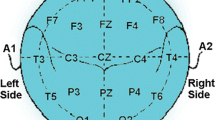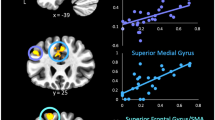Abstract
As family conflict tends to escalate during the adolescent years, the subsequent effects of adolescence on parent–child dynamics are systemically experienced, both intra- and inter-personally. As such, widening the scope of literature targeted towards better understanding the parent–adolescent conflict relationship is merited. To offer a more gestalt view of parent–adolescent conflict processes, the present study takes a biopsychosocial view of the mother–father–adolescent relationship by considering electrical brain activity using electroencephalography technology. Specifically, electrical brain activity was recorded during two problem-solving family discussions between a mother, father, and adolescent child. Data is analyzed from a pilot study of 11 triads, for a total of 33 participants, examining the statistical relationships between brain waves and self-reported measures of family functioning and distress. Findings suggest that hemispheric lateralization occurs during parent–adolescent problem-solving discussions thus reminding therapists of the importance in using a biopsychosocial lens when assisting families.

Similar content being viewed by others
References
Allen, J. P. (2008). The attachment system in adolescence. In J. Cassidy & P. R. Shaver (Eds.), Handbook of attachment: Theory, research, and clinical applications (2nd ed., pp. 419–435). New York: Guilford Press.
Anderson, J. S. (2008). Stens Corporation four-day professional EEG biofeedback certification training presentation manual. San Rafael, CA: Stens Corporation.
Atkinson, B., Atkinson, L., Kutz, P., Lata, J., Lata, K. W., Szekely, J., et al. (2005). Rewiring neural states in couples therapy: Advances from affective neuroscience. Journal of Systemic Therapies, 24(3), 3–16. doi:10.1521/jsyt.2005.24.3.3.
Bond, C. F., & Cross, D. (2008). Beyond the dyad: Prospects for social development. In N. A. Card, J. P. Selig, & T. Little (Eds.), Modeling dyadic and interdependent data in the developmental and behavioral and behavioral sciences (pp. 387–409). New York: Taylor & Francis Group.
Coan, J. A., & Allen, J. J. B. (2004). Frontal EEG asymmetry as a moderator and mediator of emotion. Biological Psychology, 67(1–2), 7–49. doi:10.1016/j.biopsycho.2004.03.002.
Cohen, J. (1988). Statistical power analysis for the behavioral sciences (2nd ed.). Hillsdale, NJ: Lawrence Erlbaum.
Cozolino, L. (2006). The neuroscience of human relationships: Attachment and the developing brain. New York, NY: W.W. Norton & Company.
D’Aniello, C. (2013). Contemporary MFT models’ alignment with relational common factors. Journal of Contemporary Family Therapy, 35(4), 673–683. doi:10.1007/s10591-013-9260-8.
Dahl, R. E. (2004). Adolescent brain development: A period of vulnerabilities and opportunities. In R. E. Dahl & L. P. Spear (Eds.), Adolescent brain development: Vulnerabilities and opportunities (pp. 1–22). New York: The New York Academy of Sciences.
Davidson, R. J., Jackson, D. C., & Kalin, N. H. (2000). Emotion, plasticity, context, and regulation: Perspectives from affective neuroscience. Psychological Bulletin, 126(6), 890–909. doi:10.1037/0033-2909.126.6.890.
Davidson, R. J., Pizzagalli, D., & Nitschke, J. B. (2009). The representation and regulation of emotion in depression: Perspectives from affective neuroscience. In I. Gotlib & C. Hammen (Eds.), Handbook of depression (pp. 218–248). New York: Guilford Press.
Delevi, R., Cornille, T., & Cui, M. (2012). Does positivity matter? The impact of interparental interactions on young adult conflict management. Journal of Contemporary Family Therapy, 34(1), 124–140. doi:10.1007/s10591-012-9179-5.
Eğeci, S. I., & Gençöz, T. (2006). Factors associated with relationship satisfaction: Importance of communication skills. Journal of Contemporary Family Therapy, 28(3), 383–391. doi:10.1007/s10591-006-9010-2.
Epstein, N. B., Baldwin, L. M., & Bishop, D. S. (1983). The McMaster family assessment device. Journal of Marital and Family Therapy, 9(2), 171–180. doi:10.1111/j.1752-0606.1983.tb01497.x.
Epstein, N. B., Bishop, D. S., & Levin, S. (1978). The McMaster model of family functioning. Journal of Marital and Family Therapy, 4(4), 19–31. doi:10.1111/j.1752-0606.1978.tb00537.x.
Hall, G. S. (1904). Adolescence; its psychology and its relations to physiology, anthropology, sociology, sex, crime, religion and education. New York: D. Appleton and Company.
Harmon-Jones, E., & Peterson, C. K. (2009). Electroencephalographic methods in social and personality psychology. In E. Harmon-Jones & J. S. Beer (Eds.), Methods in social neuroscience (pp. 170–197). New York: Guilford.
Harmon-Jones, E., & Sigelman, J. D. (2001). State anger and prefrontal brain activity: Evidence that insult-related relative left-prefrontal activation is associated with experienced anger and aggression. Journal of Personality and Social Psychology, 80(5), 797–803. doi:10.1037/0022-3514.80.5.797.
Harmon-Jones, E., & Winkielman, P. (2007). Social neuroscience: Integrating biological and psychological explanations of social behavior. New York: Guilford Press.
Jasper, H. H. (1958). The ten-twenty electrode system of the International Federation. Electroencephalography and Clinical Neurophysiology, 10, 371–375.
Kimberly, C., Werner-Wilson, R., Parker, T., & Lianekhammy, J. (2014). Alpha to omega: A neurological analysis of marital conflict in a pilot study. Journal of Contemporary Family Therapy, 36(1), 83–92. doi:10.1007/s10591-013-9296-9.
Levenson, R. W., & Ekman, P. (2002). Difficulty does not account for emotion-specific heart rate changes in the directed facial action task. Psychobiology, 39(3), 397–405. doi:10.1017/S0048577201393150.
Martin, D., Garske, J., & Davis, M. (2000). Relation of the therapeutic alliance with outcome and other variables: A meta-analytic review. Journal of Consulting and Clinical Psychology, 68(3), 438–450. doi:10.1037/0022-006X.68.3.438.
McGue, M., Elkins, I., Walden, B., & Iacono, W. G. (2005). Perceptions of the parent–adolescent relationship: A longitudinal investigation. Developmental Psychology, 41(6), 971–984. doi:10.1037/0012-1649.41.6.971.
McNamee, C. M. (2005). Bilateral art: Integrating art therapy, family therapy, and neuroscience. Journal of Contemporary Family Therapy, 27(4), 545–557. doi:10.1007/s10591-005-8241-y.
Mead, N., & Bower, P. (2000). Patient-centredness: A conceptual framework and review of the empirical literature. Social Science and Medicine, 51(7), 1087–1110. doi:10.1016/S0277-9536(00)00098-8.
Meyers, S. A., Stollak, G. E., Aronoff, J., Messé, L. A., Loraas, J. A., & Woike, B. A. (1996). Boundary regulation in family and personal systems: Perceptions of late adolescents. Journal of Contemporary Family Therapy, 18(2), 279–290. doi:10.1007/BF02196728.
Miller, I. W., Epstein, N. B., Bishop, D. S., & Keitner, G. I. (1985). The McMaster family assessment device: Reliability and validity. Journal of Marital and Family Therapy, 11(4), 345–356. doi:10.1111/j.1752-0606.1985.tb00028.x.
Miller, I. W., Ryan, C. E., Keitner, G. I., Bishop, D. S., & Epstein, N. B. (2000). The McMaster approach to families: Theory, assessment and research. Journal of Family Therapy, 22(2), 168–189. doi:10.1111/1467-6427.00145.
Moore, K. A., Young, M. S., Weir, J. M., & Ochshorn, E. (2007). An evaluation of a holistic program for at-risk teens and their parents. Journal of Contemporary Family Therapy, 29(3), 129–145. doi:10.1007/s10591-007-9041-3.
Norman, G. J., Cacioppo, J. T., & Berntson, G. G. (2009). Social neuroscience. Wiley Interdisciplinary Reviews: Cognitive Science, 1(1), 60–68. doi:10.1002/wcs.29.
Ranson, K. E., & Urichuk, L. J. (2008). The effect of parent-child attachment relationships on child biopsychosocial outcomes: A review. Early Child Development and Care, 178(2), 129–152. doi:10.1080/03004430600685282.
Robinson, M. D. (2007). Lives lived in milliseconds: Using cognitive methods in personality research. In R. W. Robins, R. C. Fraley, & R. F. Kruger (Eds.), Handbook of research methods in personality psychology (pp. 345–359). New York: Guilford Press.
Ryan, C. E., Epstein, N. B., Keitner, G. I., Miller, I. W., & Bishop, D. S. (2005). Evaluating and treating families: The McMaster approach. New York: Routledge.
Shelef, K., Diamond, G. M., Diamond, G. S., & Liddle, H. A. (2005). Adolescent and parent alliance and treatment outcome in multidimensional family therapy. Journal of Consulting and Clinical Psychology, 73(4), 689–698. doi:10.1037/0022-006X.73.4.689.
Siegel, D. J. (1999). The developing mind: How relationships and the brain interact to shape who we are. New York: Guilford Press.
Steinberg, L. (2008). A social neuroscience perspective on adolescent risk-taking. Developmental Review, 28, 78–106. doi:10.1016/j.dr.2007.08.002.
Urry, H. L., Nitchke, J. B., Jackson, D. C., Dalton, K. M., Mueller, C. J., Rosenkranz, M. A., et al. (2004). Making a life worth living: Neural correlates of well-being. Psychological Science, 15(6), 367–372. doi:10.1111/j.0956-7976.2004.00686.x.
Werner-Wilson, R. J., Lianekhammy, J., Frey, L. M., Parker, T., Wood, N. D., Kimberly, C., et al. (2011). Alpha asymmetry in female military spouses following deployment. Journal of Feminist Family Therapy, 23(3–4), 202–217. doi:10.1080/08952833.2011.604534.
Yurgelun-Todd, D. (2007). Emotional and cognitive changes during adolescence. Current Opinion in Neurobiology, 17(2), 251–257. doi:10.1016/j.conb.2007.03.009.
Author information
Authors and Affiliations
Corresponding author
Rights and permissions
About this article
Cite this article
Huff, N., Werner-Wilson, R. & Kimberly, C. Electrical Brain Activity, Family Functioning, and Parent–Adolescent Conflict Communication. Contemp Fam Ther 36, 409–416 (2014). https://doi.org/10.1007/s10591-014-9307-5
Published:
Issue Date:
DOI: https://doi.org/10.1007/s10591-014-9307-5




